Triratna
The Triratna (Pali: ti-ratana or ratana-ttaya ; Sanskrit: tri-ratna or ratna-traya) is a Buddhist symbol, thought to visually represent the Three Jewels of Buddhism (the Buddha, the Dharma, the Sangha).
| Triratna | |||||||||||
|---|---|---|---|---|---|---|---|---|---|---|---|
 Symbol of the triratna, as seen in the Sanchi stupa, 1st century BCE. | |||||||||||
| Chinese name | |||||||||||
| Traditional Chinese | 三寶 | ||||||||||
| Simplified Chinese | 三宝 | ||||||||||
| |||||||||||
| Burmese name | |||||||||||
| Burmese | ရတနာသုံးပါး | ||||||||||
| IPA | [jadanà θóʊɰ̃ bá] | ||||||||||
| Tibetan name | |||||||||||
| Tibetan | དཀོན་མཆོག་གསུམ | ||||||||||
| |||||||||||
| Vietnamese name | |||||||||||
| Vietnamese | Tam bảo | ||||||||||
| Thai name | |||||||||||
| Thai | ไตรรัตน์, รัตนตรัย | ||||||||||
| RTGS | trairat, rattanatrai | ||||||||||
| Korean name | |||||||||||
| Hangul | 삼보 | ||||||||||
| |||||||||||
| Mongolian name | |||||||||||
| Mongolian Cyrillic | ɣurban erdeni | ||||||||||
| Japanese name | |||||||||||
| Kanji | 三宝 | ||||||||||
| |||||||||||
| Bengali name | |||||||||||
| Bengali | ত্রিরত্ন trirôtnô | ||||||||||
| Lao name | |||||||||||
| Lao | ໄຕແກ້ວ (tài kɛ̂ːu) / ໄຕລັດ (tài lāt) | ||||||||||
| Part of a series on |
| Buddhism |
|---|
 |
|
Symbol
The Triratna symbol is composed of:
- A lotus flower within a circle.
- A diamond rod, or vajra.
- An ananda-chakra.
- A trident, or trisula, with three branches, representing the threefold jewels of Buddhism: Buddha, the Dharma and the Sangha.
On representations of the footprint of the Buddha, the Triratna is usually also surmounted by the Dharma wheel.
The Triratna can be found on frieze sculptures at Sanchi as the symbol crowning a flag standard (2nd century BCE), as a symbol of the Buddha installed on the Buddha's throne (2nd century BCE), as the crowning decorative symbol on the later gates at the stupa in Sanchi (2nd century CE), or, very often on the Buddha footprint (starting from the 1st century CE).
The triratna can be further reinforced by being surmounted with three dharma wheels (one for each of the three jewels of Buddhism: the Buddha, the Dharma and the Sangha).
The triratna symbol is also called nandipada, or "bull's hoof", by Hindus.
Coins
A number of examples of the triratna symbol appear on historical coins of Buddhist kingdoms in the Indian subcontinent. For example, the triratna appears on the first century BCE coins of the Kuninda Kingdom in the northern Punjab. It also surmounts the depictions of stupas, on some the coins of Abdagases I of the Indo-Kingdom of the first century CE and on the coins of the Kushan Empire, such as those coined by Vima Kadphises, also of the first century.
Examples of Triratna
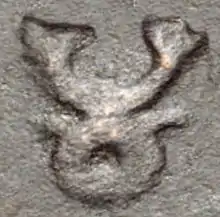 Triratna on a Taxila coin, 185-168 BCE (detail).
Triratna on a Taxila coin, 185-168 BCE (detail).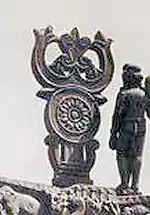 The compound Buddhist symbols: Shrivatsa within a triratana, over a Dharmacakra wheel, on the Torana gate at Sanchi. 1st century BCE.
The compound Buddhist symbols: Shrivatsa within a triratana, over a Dharmacakra wheel, on the Torana gate at Sanchi. 1st century BCE.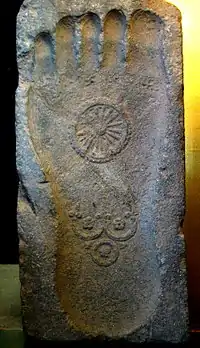 The Triratna or "Three Jewels" symbol, on a Buddha footprint (bottom symbol, the top symbol being a dharmachakra). 1st century CE, Gandhara.
The Triratna or "Three Jewels" symbol, on a Buddha footprint (bottom symbol, the top symbol being a dharmachakra). 1st century CE, Gandhara.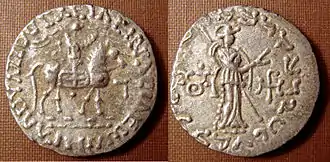 Triratna symbol on the reverse (left field) of a coin of the Indo-Scythian king Azes II (r.c. 35-12 BCE).
Triratna symbol on the reverse (left field) of a coin of the Indo-Scythian king Azes II (r.c. 35-12 BCE).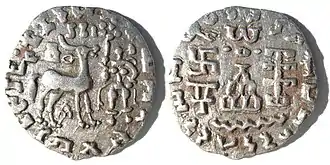
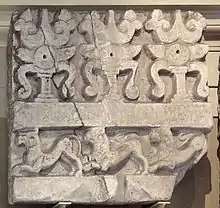 Amaravati Triratna symbols.
Amaravati Triratna symbols.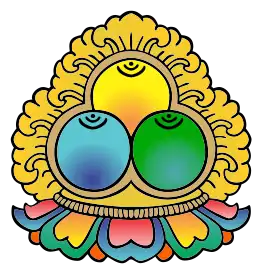 Symbol of the Three Jewels
Symbol of the Three Jewels
Notes
References
- Refuge : An Introduction to the Buddha, Dhamma, & Sangha. Thanissaro Bhikkhu : Third edition, revised, 2001
- "ガンダーラ美術の見方" (The art of Gandhara), Yamada Kihito, ISBN 4-89806-106-0
